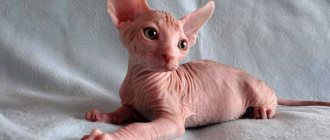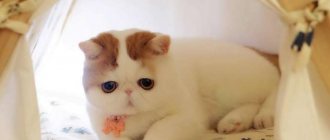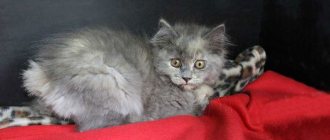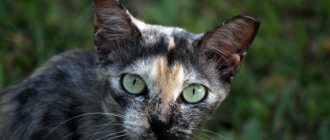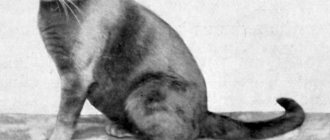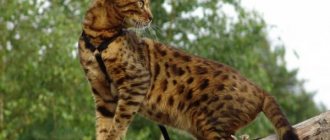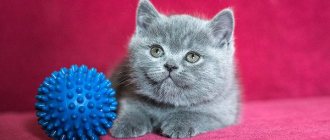Turkish van cat
- Fact 1:
In Turkish it is called Van Kedisi - “van kedisi” - Fact 2:
Belongs to a very ancient category of domestic cats - Fact 3:
Cats live up to 15 years - Fact 4:
This breed allocates one most important and only owner from all family members
The basis for the formation of the domestic cat breed under the name Turkish Van (the second option is the Van cat) was the aboriginal cat population that lived on the shores of the Turkish Lake Van. Research conducted by geneticists indicates that this spontaneously arose breed is one of the oldest.
There is a legend that the spot that many Vanir have on their shoulders was left from a divine touch. According to legend, the Van cat killed a mouse that intended to gnaw a hole in the bottom of Noah's Ark. For the salvation of animals and the human race, the Creator left a mark on her shoulder - the imprint of his finger.
History of the breed
Despite the fact that Van breed cats began to be imported to Europe since the times of the Crusades, this breed received official recognition only in the 70s of the 20th century.
The first owner of the “official” Turkish Vans was a journalist from England named Laura Lushington, who, during her trip to Turkey, became interested in the strange cats living near Lake Van. Having brought a couple of kittens with her to her homeland, Laura realized that this was an opportunity to register a new breed of cats and start breeding them. This is what she did later, going again to Turkey and bringing two more Van kittens.
The first cats recorded in the history of the breed were named Van Atilla and Van Guzeli Iskenderun.
Turkish Van, description of the breed. Official Standards
Laura Lushington was the first owner of this breed
WCF standards provide the following criteria for the breed:
- For the body: muscular, well-developed body, strong chest and massive neck.
- For paws: medium in size, round in shape, with elongated hair between the toes.
- For the coat: silky, medium length, without undercoat. The tail is longer than the body.
- For the eyes: the shape of the eyes is oval, slightly elongated towards the temples, the color is blue and yellow. Or each eye is a different color.
- For the ears: wide at the base, rounded at the top. They stand straight, located high. Quite large in size.
- For the head: the head is medium in size, shaped like a truncated triangle. The chin is massive.
Breed characteristics
The Turkish Van is a large semi-longhaired cat breed. From the nose to the tip of the tail, its length varies between 90-120 cm. The height at the withers of adult cats reaches 40 cm, weight - 7-9 kg and they are fluffier than cats. And cats are much more graceful and smaller - 4-6 kg.
Vans have an elongated body, a massive neck, medium-sized paws, tufts of hair between the toes, and a wide and muscular chest. The head is medium in size and looks like a truncated triangle. The eyes are oval, blue or yellow, there are many individuals with different eyes (the iris of one eye is blue, and the other is yellow). The ears are wide at the base, with rounded tips.
The coat is silky, medium length on the body, and much longer on the tail. Almost or completely no undercoat (in this regard, the requirements of organizations vary). The body is always white, but the tail and spots on the body can be painted in other colors. The standards of the Van breed in the classifications of different felinological organizations have some differences, in particular, this concerns the colors and structure of the coat.
Recognized color options:
- Classic Van. Approved by all felinological organizations. The tail is red-chestnut, has 5-9 more intensely colored rings. The same color spots are located in the muzzle area and near the ears, sometimes in the area of the shoulders and back, the steel body is painted white;
- Tortoiseshell;
- Blue;
- Cream;
- Black.
Pure white cats are recognized by the TICA organization with the condition that they will be mated only with individuals of the traditional Van color.
Types of Turkish Van colors and photos of cats
There are 4 color combinations considered official for the breed:
- Combination of black blue and red
- Combination of black and cream
- Combination of blue and tortoiseshell
- Tortoiseshell Tabby (coat pattern)
There are separate bathtubs that are completely white . White Van Kedisi have been recognized by TICA with the caveat that they will only be crossed with individuals of the traditional Van coloration.
Features of color
The main difference between the breed is the colored spots on a white background. Patterns and shades vary. Sprinkles of white are acceptable at the tip of the tail. The most popular pattern is tabby stripes.
Followers of Islam believe that Allah himself left these marks on the cat, blessing it to fight rodents that were supposed to destroy Noah's ark. Markings are most often cream, red, blue, and black. The paw pads and nose of this breed are usually pink.
Socialization
Vans easily find a common language with all family members, but usually they choose one owner, whom they treat with special love and respect. They are patient and friendly with children, but do not like it when they encroach on their independence and try to force them to do anything.
Van cats are also calm about the presence of another cat or dog in the house, but with the condition that they will dominate in this relationship. But it is dangerous to have various rodents in the house where a van lives - these cats are born hunters and a mouse or hoyak will quickly become their prey.
Character
Representatives of the breed are friendly, devoted to people, intelligent, love to be cuddled, but are reluctant to be held. Reviews from owners show that they are easy to train. They are easily accustomed to the tray and leash. They get along well with children, but do not allow themselves to be treated too freely.
Powerful, well-developed leg muscles allow cats to be jumping, so it is not surprising to see a pet on a closet, wall shelf or curtain under the curtain rod. This fact must be taken into account and the pet must be provided with a ball, toys and active games.
Genetic features: the ability to swim, lack of undercoat and waterproof wool, which arose under the influence of wild nature.
Physical activity
The Turkish Van breed is very active and agile.
Unlike the pets of most breeds, Turkish Vans are very mobile and active. They participate in all household chores, love to climb to higher places, be it a closet or a tree, play games with running around the apartment and sleep little.
Vans need toys and owners who will keep them company in their next chase of a ball or a candy wrapper on a string. You shouldn’t brush off your pet who wants to play – this is vital for him.
And cats of this breed love to swim. You should sometimes give this pleasure to your pet. If it is not possible to provide him with water treatments in a pond, that’s okay. They adapt perfectly to the bathroom, you just need to make sure that the water is not hot or too cold.
Owner reviews
“This is the first time I’ve seen a cat who loves to swim so much! Our Leopard loves water treatments. This is probably because before these were wild cats, they caught their own fish and became accustomed to water. And Leopard is also very beautiful, fluffy and snow-white. He is very affectionate, always sleeps in his head on the pillow and never conflicts with our dog. Although he was not noticed to have any special love for her.” Konstantin, Simferopol.
***
“Our Lizonka is almost 10 years old. Turkish Van, that’s the name of her breed, we took her on purpose. Or rather, they were looking for a cat with a suitable character, and the choice fell on this breed. Lizok is calm, although capricious. It is not fussy about food; it can eat both dry food and regular food. Her weakness is fish, she even tries to fish in an aquarium. She is also fascinated by the sight of water flowing from the tap. He can watch the stream for hours and try to play with it. He loves children, a lot and with pleasure, allows himself to be cuddled, but does not give offense.” Elena, Kursk.
***
My Assol was found in the trash. She was looking for food, she was terribly dirty, with deep cuts, apparently, she had fought with other stray cats. I felt sorry for her, I just fed her, and she followed me. Then I washed her, treated her, vaccinated her. Now I will not give up this affectionate miracle for any money. I had never heard of the Turkish Van breed before, but now I know that they are the best cats in the world. She is neat, understands the word “impossible” very well, loves people, is very grateful and unpretentious.” Svetlana, Smolensk.
Nutrition, care and maintenance of the Turkish Van
The Turkish Van is not a fussy eater
The Turkish Van is a very unpretentious creature. They easily adapt to both private houses and apartments. But they love freedom, so if possible, you should let them out into the street. If this is not possible, then you need to provide them with access to the window sills - cats of this breed cannot live completely isolated from the outside world. Vans also do not tolerate various cat houses that limit their space.
Cats of this breed are not demanding in care - all they need is brushing once every 3-4 days (when shedding once every 1-2 days).
Vans are as unpretentious in nutrition as in everything else, so any complete cat diet is quite suitable for them. They especially will not refuse fish - after all, Vans are born fishermen.
But you should be careful - you are allergic to baths. You need to carefully monitor your pet's reaction to any food. If a cat has an allergic reaction, you should choose a good dry food, preferably a premium one, which is designed taking into account all the characteristics of the cat’s body.
Maintenance and care
The wool of Vans is not prone to tangling, has dirt- and moisture-repellent properties, brushing it 1-2 times a week is quite enough, during periods of heavy shedding - 2-3 times a week. Shedding in cats of this breed is seasonal, occurring in spring and autumn.
Although Vans love water, they should not be washed frequently. An exception is if the cat is very dirty, an exhibition is approaching, or the owner is allergic to cat fur: in this case, the cat can be washed once every 6 weeks, this will avoid provoking allergic attacks in the owner.
If a cat's claws grow excessively, they need to be carefully trimmed with a nail clipper. It is enough to wipe the eyes and ears once a week, clean the teeth with a soft brush and toothpaste for animals 1-2 times a week.
Van cats love walks, so it is useful to regularly walk them on a harness with a leash. If it is not possible to go outside with your pet, you need to set up a place for him on the balcony or windowsill, where he could look out the window.
The smarter the animal, the more entertainment it needs. When it comes to the Turkish Van, there is no such thing as too much play. You need to pamper him with new toys regularly, you can also hide old ones for a while. Cats of this breed love interactive cat toys that use logic.
In addition to this, it is advisable to purchase or make your own play set for your pet with scratching posts and an open-type bed located at a considerable height, since cats of this breed love to watch what is happening from above.
Vans get used to the litter box quickly. Any type of toilet is suitable for them, but keeping in mind the ease of allergies, it is better to choose filler for their litter box without fragrances.
Health
Allergies are a common problem for this breed.
Turkish Vans are surprisingly healthy animals, apparently due to the natural formation of the breed. At the moment, not a single genetic disease has been detected in them. The only exception is the completely white van kedisi - they often have congenital deafness in one or two ears. But the same can be said about white cats of any breed.
The most common ailment encountered in this breed is allergies , so the choice of food should be approached very responsibly. Otherwise, Van cats are healthy animals in all respects. But this does not mean that you should neglect the necessary vaccinations and not pay due attention to caring for your pet.
Where to buy a kitten
There are no nurseries for breeding this breed in Russia.
The impressive cost is not the only problem that arises when you want to have a pet of this breed. The most difficult process is the search and acquisition process (which, by the way, largely affects the price) - in our country there are no officially registered nurseries of the Turkish Van breed. Of course, many breeders breed them, but in this case problems may arise with standards and documents.
The only way to buy a full-fledged representative of the breed is to order from a foreign nursery. But, as mentioned earlier, it will cost several thousand euros. This is due to the fact that the Van is a rare breed, there are very few nurseries in Europe, and it is almost impossible to take a cat out of Turkey , only with a special permit.
And the easiest and cheapest option is to buy a kitten secondhand. Of course, in this case there is no hope for ideal purebredness, compliance with standards and a complete set of documents, but if the goal is to acquire a pet with an exotic appearance, then this is not so important.
Van cat cost
Acquiring a representative of this breed is not an easy task. There are very few breeders in Russia and neighboring countries, and the cost of cats is quite high. Here it is important to carefully study the reviews and pedigree. The seller is obliged to provide a passport of the kitten’s parents, documents certifying that the animal belongs to the breed.
The average cost of a small kitten in Russia starts from 10,000-20,000 rubles and is much higher depending on the pedigree. The cost will include the cost of preparing the pet for shipment and issuing certificates, since most often it is brought from abroad.
Even in Turkey, Vans should only be purchased from official breeders; their price in their historical homeland starts from a thousand dollars. It’s better to go look at the kittens with a specialist. But you can also explore the issue yourself and take into account the following details:
- Almost equal rings of two colors should run along the kitten’s tail;
- the presence of small spots on the back is acceptable;
- There are purebred kittens from individuals belonging to the same breed, and breeds with admixtures, which may cost less.
It is extremely rare, but still, a van can be accidentally found on the street if it was thrown out by some unscrupulous owner. You can also look at advertisements for cat shelters, which often house lost animals. Many also give away their pets due to moving or for other reasons (allergy to wool, birth of a child). Therefore, there is always a chance to become the owner of a handsome thoroughbred at minimal cost.
What to look for when buying Turkish Van kittens
Buy kittens only from certified nurseries
Before buying a Turkish van, there are a few things you should pay attention to.
- Breeder's reputation. When buying a kitten from a breeder (no matter domestic or foreign), you should first find out everything about it - look for reviews, check the availability of the necessary documents, check the living conditions of the animals.
- Compliance. Moving directly to the choice, you need to examine the kittens, check how well they and their parents correspond to the description of the breed, and carefully check the documents. This is especially true when purchasing from a private person.
- Kitten behavior. When choosing a pet, you should pay attention to how it reacts to humans.
In some cases, kittens are not accustomed to people, they run away from them and even try to defend themselves with aggression. This is most often observed in animals from a nursery if they are not given attention. It is difficult to tame such a cat, and if there are small children in the house, then it is not worth the risk. - Appearance and behavior. Healthy animals have a well-groomed appearance and are very active. Lethargy and apathy may indicate that their health is not all right.
Origin of the breed
There are several versions of the appearance of the Turkish Vans. The most popular legend dates back to the time of the Flood. According to it, after Noah took two white cats into the ark and landed on the shores near Mount Ararat, the animals descended to earth and became the progenitors of the entire cat family on earth. In the Van region, which belongs to modern Turkey, the remains of representatives of this breed were found, which lived here for many thousands of years. In addition to Turkey, these varieties live in Iraq, Syria, Iran, Armenia, and are actively spreading.
Turc de Van
It is believed that the proximity to Lake Van gave the animals the ability to swim. This is one of the highest lakes in the world, and the area is famous for its extreme temperatures. In order not to freeze in winter and easily cope with difficulties, the Turkish van has adapted over time. Light wool allows them to float well and withstand heat. The structure of their coat allows them to emerge from the water almost dry. In winter, the undercoat becomes thicker, and they easily get used to the cold. That is why, regardless of climatic conditions, anyone can become the owner of a Turkish van.
When archaeologists explored the region that gave the name to this breed, they found many artifacts depicting representatives of this family. Many finds date back to the 2nd millennium BC. Perhaps this is one of the most ancient breeds in the world.
It is interesting that if the Turks had not captured part of the territory of Armenia, where Lake Van is located, the cats would not have been called “Turkish”, but “Armenian”. In Armenia they are highly valued for their flexible nature.
If animals were brought to Europe by the crusaders, then they explored the Middle East together with traders. The modern history of such cats began in 1955, when British journalists went to Turkey to prepare a program about the country, meeting representatives of an unusual feline species there. One of the journalists was then given two red and white kittens. In 1959, the couple was joined by a cat named Anatolia (which is why the Turkish Van is also known as the Anatolian).
Cats arrived in the United States in 1970, but did not become popular until 1983. A couple of years later, the International Cat Association recognizes Turkish Vans as full-fledged representatives of the breed.
In 1992, the media reported that only 92 original Turkish Vans had been discovered in their homeland. As a result, the government developed a program to protect animals and preserve the species. Today, such cats are a national treasure, and their import is prohibited. This creates a number of difficulties in terms of breeding animals, since there are quite a few of them in the USA and Europe.



